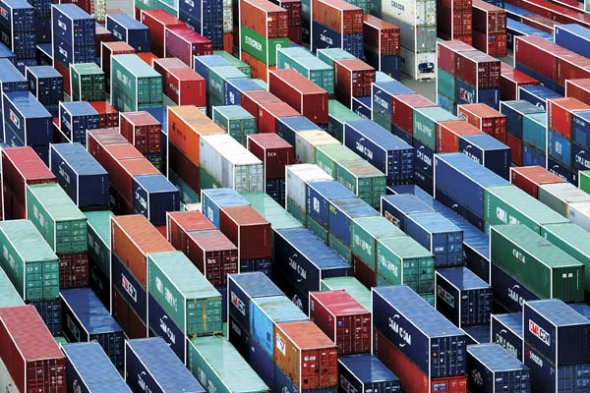Logistics and Opposition
‘Sabotage the social machine’. ‘Incinerate the documents!’ In the first in this issue’s series of articles linking logistics, workplace surveillance and national security, Alberto Toscano examines the anti-urbanist presuppositions of insurrectionary anarchism. Instead of breaking the lines of circulation, he writes, shouldn’t radicals imagine repurposing them to entirely new ends?
The Spontaneous Philosophy of Interruption
It is rare, in contemporary oppositional thought, to encounter the totalising temporal imaginary of revolution that so marked the visions and strategies of the modern left. When it hasn’t been victim to melancholy retreats from the teleology of emancipation, that encompassing horizon of social change and political action has come under attack, alongside the very idea of transition, for domesticating antagonism. Interstitial enclaves or temporary liberated zones, ornamented by discourses of withdrawal and difference, have widely replaced the reference to an advancing, unifying and largely homogeneous planetary movement of liberation. The space-time of much of today's anti-capitalism is one of subtraction and interruption, not attack and expansion.
Needless to say, any negation of the status quo brings with it spatial separation and temporal disruption, but the contemporary ideology, or spontaneous philosophy, of interruption appears – perhaps as a testament to the claustrophobia of our present – to make something of a fetish out of rupture. This cuts across theory and activism, laying bare a shared structure of feeling between the political metaphysics of events or ‘dissensus’ and the everyday tactics of struggles. Foregrounding interruption implies a particular understanding of the nature of contemporary capital, the capabilities of antagonism and the temporality (or lack thereof) of transformation.
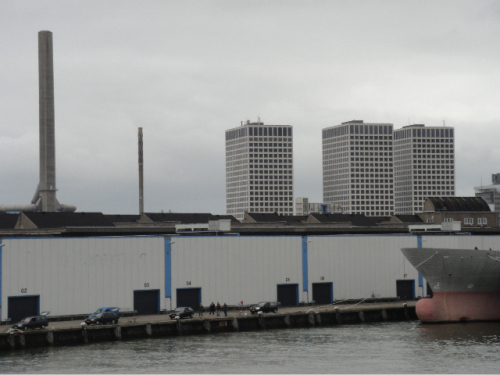
Image: Alberto Toscano, Rotterdam (June, 2010)
The Coming Insurrection formulates, in a compellingly abrasive way, a widespread conviction that contemporary struggles against capital have shifted from the point of production to those of circulation, distribution, transport and consumption. In other words, that arresting the flow of this homogenised society is a conditio sine qua non for the irruption of non-capitalist forms-of-life:
The technical infrastructure of the metropolis is vulnerable. Its flows amount to more than the transportation of people and commodities. Information and energy circulate via wire networks, fibres and channels, and these can be attacked. Nowadays sabotaging the social machine with any real effect involves reappropriating and reinventing the ways of interrupting its networks. How can a TGV line or an electrical network be rendered useless?1
Behind this statement lies an anti-urbanism that regards contemporary spectacular exploitation and conformity as products of the capillary management of everyday life. Cities are stripped of any life not mobilised for the commodity and pre-empted from any behaviour at odds with a tautological drive for systemic reproduction:
The metropolis is not just this urban pile-up, this final collision between city and country. It is also a flow of being and things, a current that runs through fiber-optic networks, through high-speed train lines, satellites, and video surveillance cameras, making sure that this world keeps running straight to its ruin. It is a current that would like to drag everything along in its hopeless mobility, to mobilize each and every one of us.2
The interruption or sabotage of the infrastructure of mobilisation are the other side of The Coming Insurrection's conception of communes not as enclaves for beautiful souls, but as experiences through which to develop the collective organs to both foster and endure the crisis of present, and to do so in a fashion that does not sever means from ends. The book's catastrophic optimism lies in advocating that interruption is somehow generative of anti-capitalist collectivity (rather than passing irritation or mass reaction). It is also founded on a repudiation of the inauthenticity of massively mediated, separated and atomised lives in the metropolis.
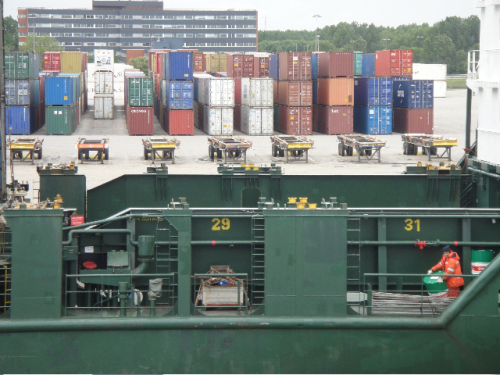
Image: Alberto Toscano, Rotterdam (June, 2010)
There are inadvertent echoes of Jane Jacobs in the scorn against ‘indifferent’ modern housing and the idea that with ‘the proliferation of means of movement and communication, and with the lure of always being elsewhere, we are continuously torn from the here and now’.3 Real communities that do not rest on the atrophying of bodies into legal identities and commodified habits are to emerge out of the sabotaging of all the dominant forms of social reproduction, in particular the ones that administer the ubiquitous mobilisation of ‘human resources’. Materialism and strategy are obviated by an anti-programmatic assertion of the ethical, which appears to repudiate the pressing critical and realist question of how the structures and flows that separate us from our capacities for collective action could be turned to different ends, rather than merely brought to a halt.
The spatial vocabulary articulated in The Coming Insurrection is, to employ a well worn dichotomy, not one of revolution but one of revolt. This spatial distinction between negations of the status quo was beautifully traced through the relationship between Rimbaud and the Paris Commune by the Italian critic Furio Jesi. Jesi begins with the evident temporal distinction between revolution conceived in terms of the conscious concatenation of long- and short-term actions aimed at systemic transformation in historical time and revolt as a suspension of historical time. Revolt is not the building up but the revelation of a collectivity. It is, to borrow from André Malraux’s Hope, an organised apocalypse.
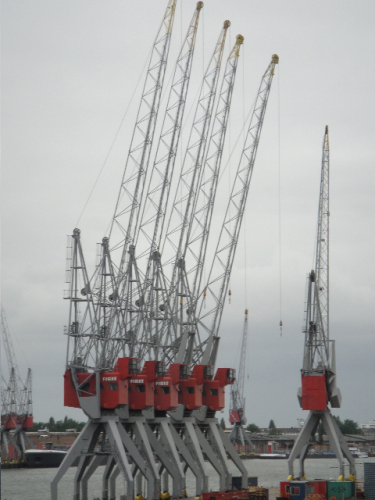
Image: Alberto Toscano, Rotterdam (June, 2010)
In this abrogation of the ordered rhythms of individual life, with its incessant sequence of personal battles, revolt generates ‘a shelter from historical time in which an entire collectivity finds refuge’.4 But the interruption of historical time is also the circumscription of a certain a- or anti-historical space, a space torn from its functional coordinates:
Until a moment before the clash […] the potential rebel lives in his house or his refuge, often with his relatives; and as much as that residence and that environment may be provisional, precarious, conditioned by the imminent revolt, until the revolt begins they are the site of an individual battle, more or less solitary. [...] You can love a city, you can recognise its houses and its streets in your most remote and secret memories; but only in the hour of revolt is the city really felt like an haut-lieu [a high place] and at the same time your own city: your own because it belongs to you but at the same time also to others; your own because it is a battlefield you and the collectivity have chosen; your own, because it is a circumscribed space in which historical time is suspended and in which every act has its own value, in its immediate consequences.5
The collective experience of time, and of what Jesi calls symbols (such that the present adversary simply becomes the enemy, the club in my hand the weapon, victory the just act, and so on), means that the revolt is an action for action's sake, an end (as in The Invisible Committee's reflections on the ethics of sabotage and the commune) inseparable from its means.
It was a matter of acting once and for all, and the fruit of the action was contained in the action itself. Every decisive choice, every irrevocable action, meant being in accordance with time; every hesitation, to be out of time. When everything came to an end, some of the true protagonists had left the stage forever.6
Abiding with the interruptive paradigm of an intransitive and intransigent revolt, we can wonder whether, and if so to what extent, the historical space that revolt intervenes in inflects its character. It is no accident that the kind of sabotage envisioned in The Coming Insurrection is on lines and nodes of circulation, and not on the machinery of production itself.
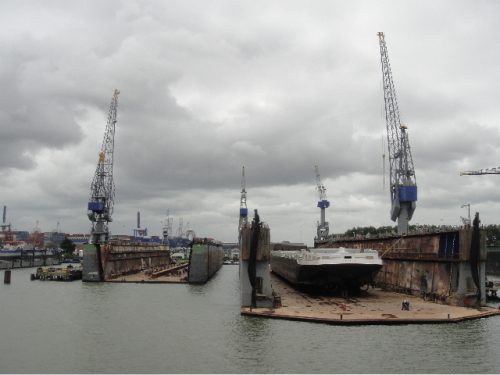
Image: Alberto Toscano, Rotterdam (June, 2010)
The Triumph of Processing
The centrality to an intensely urbanised capital of the efficient, profitable, ceaseless and standardised movement of material and information – the very target of The Coming Insurrection’s ethics of interruption – has been noted for a long time. Fifty years ago, Lewis Mumford, writing in The City in History of the catastrophic propensities of the contemporary metropolis – what he elegantly called 'the aimless giantism of the whole' – pointed to the pivotal role of the growing possibilities of supply to the 'insensate agglomeration of populations' in exponentially expanding cities, and their relations to the ‘tentacular bureaucracies’ that controlled such flows of goods.
During the 19th century, as populations heaped further into a few great centres, they were forced to rely more fully on distant sources of supply: to widen the basis of supplies and to protect the ‘life-line’ that connects the source with the voracious mouth of the metropolis, became the function of army and navy. In so far as the metropolis, by fair means or foul, is able to control distant sources of food and raw materials, the growth of the capital can proceed indefinitely.7
The organisational and energetic resources required to reproduce the metropolis are formidable: ‘like Alice's red queen, by great exertion and utmost speed the metropolis barely manages to remain in the same position.’8 The metropolis has the intensification and expansion of supply lines as its precondition, and logistics becomes its primary concern, its foremost product, and the basic determinant of its power:
The metropolis is in fact a processing centre, in which a vast variety of goods, material and spiritual, is mechanically sorted and reduced to a limited number of standardized articles, uniformly packaged, and distributed through controlled channels to their destination, bearing the approved metropolitan label. ‘Processing’ has now become the chief form of metropolitan control.9
Despite his systemic objections to the catastrophic ends of this amorphous machine for (capital) accumulation, Mumford also regards these control capabilities as potentially reconfigurable in a multi-centred and organic society. But, especially when it comes to the informational requirements attendant on such control-by-processing, manifest in the metastasis of a tentacular bureaucracy, he too is tempted by the possibilities of insurgent interruption – even recalling an anarchist slogan (‘Incinerate the documents!’) to stress the ease with which such a system, founded on the circulation of real or virtual ‘paper’, could be ground to a halt.
But it is also possible, and indeed necessary, to think of logistics not just as the site of interruption, but as the stake of enduring and articulated struggles. Here there remains much to digest and learn from in the ongoing research of labour theorist and historian Sergio Bologna, an editor in the 1970s of the journal Primo Maggio, which carried out seminal inquiries into containerisation and the struggles of port workers.10 Countering those ‘post-workerists’ who have equated post-Fordism with the rise of the cognitive and the immaterial (and basically with the ubiquity of a figure of work patently traced on that of the academic or ‘culture worker’), Bologna notes that the key networks that condition contemporary capitalism are neither affective nor simply digital, but involve instead the massive expansion and constant innovation in the very material domain of logistics – in particular of ‘supply chain management‘, conceived of in terms of the speed, flexibility, control, capillary character and global coverage of the stocking, transport and circulation of services and commodities.11
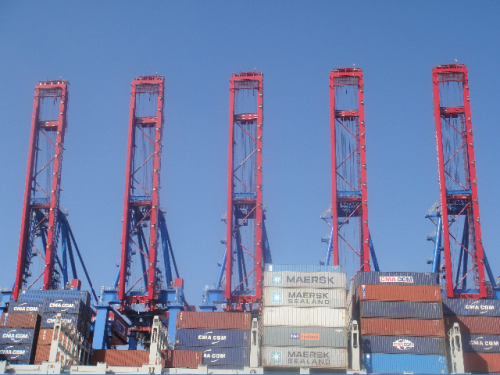
Images: Alberto Toscano, Hamburg (June, 2010)
Bologna underscores the military origins of logistics, namely in the work of de Jomine, a Swiss military theoretician working first under Napoleon and then under the Russian Tsar Alexander I. The ‘original function of logistics’, writes Bologna,
was to organise the supplying of troops in movement through a hostile territory. Logistics is not sedentary, since it is the art of optimizing flows […] So logistics must not only be able to know how to make food, medicines, weapons, materials, fuel and correspondence reach an army in movement, but it must also know where to stock them, in what quantities, where to distribute the storage sites, how to evacuate them when needed; it must know how to transport all of this stuff and in what quantity so that it is sufficient to satisfy the requirements but not so much as to weigh down the movement of troops, and it must know how to do this for land, sea and air forces.12
He goes on to analyse how the problems of logistics have been central to the ongoing transformations of contemporary capitalism, from the just-in-time organisation of production of ‘Toyotism’, to the world-transforming effects of containerisation (itself accelerated by its military-logistical use in the Vietnam War).13 The homogenisation registered at an existential level by The Coming Insurrection is here given a very prosaic but momentous form in the standardisation and modularisation that characterises a planetary logistics which, in order to maintain the smoothness and flexibility of flows, must abstract out any differences that would lead to excessive friction and inertia.
For my purposes, however, what is paramount is what this logistical view of post-Fordism tells us about the character of antagonism, and specifically of class struggle. Narcissistically mesmerised by hackers, interns and precarious academics, radical theorists of post-Fordism have ignored what Bologna calls ‘the multitude of globalisation’, that is all of those who work across the supply chain, in the manual and intellectual labour that makes highly complex integrated transnational systems of warehousing, transport and control possible. In this ‘second geography’ of logistical spaces, we also encounter the greatest ‘criticality’ of the system – though not, as in the proclamations of The Coming Insurrection, in the isolated and ephemeral act of sabotage, but in a working class which retains the residual power of interrupting the productive cycle – a power that offshoring, outsourcing, and downsizing has in many respects stripped from the majority of ‘productive’ workers themselves.
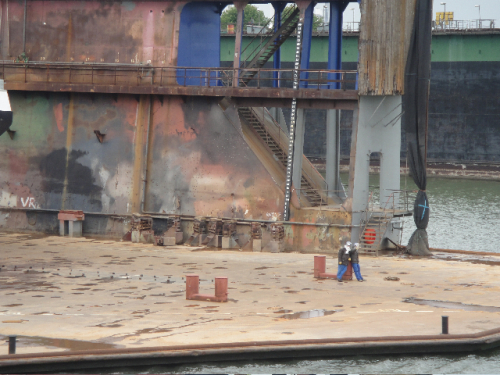
Image: Alberto Toscano, Rotterdam (June, 2010)
Here it is possible to link the question of logistics quite closely to that of the management of labour and the neutralisation of class struggle, in a way that sheds some doubt on the ‘criticality’ identified by Bologna. The expulsion of a mass labour force from containerised ports, their physical separation from zones of urbanisation and connection to other labourers, as well as the deeply divisive labour regulations that divide an international maritime labour force are an important instance of this. As Tim Mitchell writes in his fine essay on energy and the spatial history of class struggle, ‘Carbon Democracy’:
Compared to carrying coal by rail, moving oil by sea eliminated the labour of coal-heavers and stokers, and thus the power of organized workers to withdraw their labour from a critical point in the energy system […] [W]hereas the movement of coal tended to follow dendritic networks, with branches at each end but a single main channel, creating potential choke points at several junctures, oil flowed along networks that often had the properties of a grid, like an electrical grid, where there is more than one possible path and the flow of energy can switch to avoid blockages or overcome breakdowns.14
Refunctioning the Spaces of Capital
The electrical grid provides an apt transition to reflecting on the relationship between the logistics of capital and the spatial politics of anti-capitalism in a manner that does not merely involve the bare negation or mere sabotage of the former by the latter. The power grid (contrasted with the railway network) was in fact a system whose capabilities for coordinated decentralisation were emphasised by Mumford as a necessary model for a shift out of an aimlessly urbanising capitalism. Following Mumford, a number of Marxist theorists have of late reflected – in a mode that, to borrow a recent quip from David Harvey, we could call pre-communist rather than post-modern – on what aspects of contemporary capitalism could be refunctioned in the passage to a communist society. Obversely to The Coming Insurrection, they have asked how could a high-speed rail system or an electrical network be rendered not useless, but useful – in what would clearly need to be a thoroughly redefined conception of use, one not mediated and dominated by the abstract compulsions of value and exchange.
It is striking that many of these authors have put logistical questions at the forefront of these thought experiments, almost as though logistics were capitalism's pharmakon, the cause for its pathologies (from the damaging hypertrophy of long-distance transport of commodities to the aimless sprawl of contemporary conurbation) as well as the potential domain of anti-capitalist solutions. In this vein, Fredric Jameson has recently, and somewhat perversely, identified the distribution systems of Wal-Mart, the very emblem of capitalism's seemingly inexhaustible capacity for devastating mediocrity, as precisely one of those aspects of capitalism whose dialectical refunctioning, or whose change of valence, could give a determinate character to our social utopias.15

Image: Alberto Toscano, Cafe Paris, Hamburg (August, 2010)
The ambivalence of logistics, and particularly of the environmental consequences of the unprecedented logistical and energetic complexes that make contemporary megalopolises both the drivers and the possible sites for a response to catastrophic climate change (among other processes) have led Mike Davis, in his appropriately titled ‘Who Will Build the Ark?’, to demand that, recalling the great experiments in urbanism of the USSR in the 1920s, we begin to look for the potentialities for a non-capitalist and non-catastrophic future in cities themselves.16 In particular, Davis has advanced, to borrow from Mitchell, some of the parameters of a low-carbon democratic socialism. Arguing, contrary to the Malthusianism of much of the green movement that it is ‘the priority given to public affluence over private wealth’ that can set the standard for a conversion of engines of doom into resources of hope.
As Davis writes:
Most contemporary cities repress the potential environmental efficiencies inherent in human-settlement density. The ecological genius of the city remains a vast, largely hidden power. But there is no planetary shortage of ‘carrying capacity’ if we are willing to make democratic public space, rather than modular, private consumption, the engine of sustainable equality.17
Such an assertion of the necessity of a drastic transition, as against plural but ineffectual interruptions, takes logistic and energetic dimensions of anti-capitalist struggle more seriously than the convergence of anti-urbanist visions of space and epiphanic models of revolt that – for evident and in many respects sacrosanct historical and political reasons – have come to dominate much anti-capitalist thought.18 It also does so by recognising what, by analogy with Herbert Marcuse, we could call the necessary alienation involved in complex social systems, including post-capitalist ones. As David Harvey has noted, against the grain of fantasies of a tabula rasa, unmediated communism or anarchism:
The proper management of constituted environments (and in this I include their long-term socialistic or ecological transformation into something completely different) may therefore require transitional political institutions, hierarchies of power relations, and systems of governance that could well be anathema to both ecologists and socialists alike. This is so because, in a fundamental sense, there is nothing unnatural about New York city and sustaining such an ecosystem even in transition entails an inevitable compromise with the forms of social organization and social relations which produced it.19
The question of what use can be drawn from the dead labours which crowd the earth's crust in a world no longer dominated by value proves to be a much more radical question, and a much more determinate negation than that of how to render the metropolis, and thus in the end ourselves, useless.
Alberto Toscano <sos01at@gold.ac.uk> teaches at Goldsmiths, University of London and sits on the editorial board of Historical Materialism. He is the author of Fanaticism: On the Uses of an Idea, London: Verso, 2010
Note
Versions of this article were originally presented at the Spaces of Alterity conference at University of Nottingham, and The Anarchist Turn colloquium at the New School for Social Research. I’m grateful to the organisers for providing me with the occasion to hone some of these ideas. Thanks to Jason Smith, Joshua Clover, Evan Calder Williams, Benjamin Noys, Josephine Berry Slater and Benedict Seymour for references, critique and inspiration.
Footnotes
1 The Invisible Committee, The Coming Insurrection, Los Angeles: Semiotext(e), 2009, pp.111–12. These reflections prolong those initially spurred by the so-called Tarnac affair, which saw this anonymous argument for sabotage transformed into the flimsy basis for a prosecutorial campaign at once vicious and spurious. See my ‘The War Against Pre-Terrorism’, Radical Philosophy, issue 154, 2009, pp.2-7, http://www.radicalphilosophy.com/commentary/the-wa....
2 The Coming Insurrection, pp.58-9.
3 Ibid., p.59.
4 Furio Jesi, Lettura del ‘Bateau ivre’ di Rimbaud (1972), Macerata: Quodlibet, 1996, p.22.
5 Ibid., pp.23–4.
6 Ibid., p.24.
7 Lewis Mumford, The City in History, New York: Harcourt, 1961, p.539.
8 Ibid., p.540.
9 Ibid., pp.541–2.
10 For an excellent introduction to the work of Bologna and Primo Maggio in English, which stresses the way in which it both prolonged and challenged operaismo through a historiographic lens, see Steve Wright, Storming Heaven: Class Composition and Struggle in Italian Autonomist Marxism, London: Pluto, 2002, chapter 8: ‘The Historiography of the Mass Worker’. The full collection of Primo Maggio is now available as a CD-ROM in La rivista Primo Maggio (1973-1989), Cesare Bermani (Ed.), Rome: DeriveApprodi, 2010.
11 For an incisive and informed treatment of the logistics revolution and the challenge it poses to workerist and autonomist perceptions of class struggle, see Brian Ashton, ‘The Factory Without Walls’, Mute, http://www.metamute.org/en/Factory-Without-Walls. Ashton underscores the link between any future resurgence of oppositional anti-capitalist organising and knowledge of capital’s composition and operation – the cognitive mapping of supply chains, value extraction and the levers of struggle.
12 Sergio Bologna, ‘L’undicesima tesi’, in Ceti medi senza futuro? Scritti, appunti sul lavoro e altro, Rome: DeriveApprodi, 2007, p.84.
13 See Marc Levinson, The Box: How the Shipping Container Made the World Smaller and the World Economy Bigger, Princeton: Princeton University Press, 2008, chapter 9.
14 Timothy Mitchell, ‘Carbon Democracy’, Economy & Society 38.3, 2009, p.407.
15 Fredric Jameson, ‘Utopia as Replication’, in Valences of the Dialectic, London: Verso, 2009, pp.420–434.
16 An interrogation of the logistical dimensions of transition, state building and class struggle in the USSR would need to take its cue from chapter four of Robert Linhart’s arresting study of the conjunctural and contradictory character of Lenin’s thought and politics post-1917, Lénine, les paysans, Taylor, re-edited by Seuil in 2010 – a book quite unique in its combination of a real appreciation of Lenin with a welcome rejection of the comforting apologias of Leninism. This chapter, entitled ‘The railways: the emergence of the Soviet ideology of the labour-process’, details how, in the context of the famine, the authoritarian Taylorist turn in the organisation of work was driven through in that sector which provided the vital hinge between production, services and administration, and whose critical disorganisation was exacerbated by the very autonomous workers’ organisation that had previously made it into a hub of anti-Tsarist organising, and now appeared as a kind of economic blackmail all the more menacing in that it took place within the crisis of the civil war. The Bolsheviks, he notes, were ‘almost instinctively attentive to everything that concerns communication, flow, circuits’ (p.151). In this moment, the railways appeared as the nerve fibres and life blood of a ‘state in movement’, and militarised centralisation, planning and labour discipline as imperatives – as evidenced, among others, by Trotsky’s ‘order 1042’, viewed by Linhart as the first key instance of state planning. After all, ‘if there is an activity that must, by nature, function as a single mechanism, one that is perfectly regulated, standardised and unified throughout the country, it’s the railway system’ (p.162). The seemingly inevitable Taylorisation of the railways both forges and deforms the USSR, especially in furthering the split, thematised by Linhart, between the proletarian as political subject and as object of iron discipline. Among the more interesting sites of the necessary fixation on logistics (namely, on railways and electrification) are the films of Dziga Vertov, which promise a cognitive mapping that would join the Taylorist decomposition of labour, imaged as ‘a regular, uninterrupted flow of communication’, and its subjective mastery, in which the ‘transparency of the productive process’ (p.169) is provided to each worker in the guise of an all encompassing vision.
17 Mike Davis, ‘Who Will Build the Ark?’, New Left Review II/61 (2010), p.43.
18 For a transitional proposal or ‘determinate negation of the existent’ that stakes some of the same ground as Davis and Harvey, albeit from a different Marxian vantage, see Loren Goldner, ‘Fictitious Capital and the Transition Out of Capitalism’, http://home.earthlink.net/~lrgoldner/program.html . In his inventory of transitional negations and the refunctioning of ‘total existing means of production and labour power’, now grasped as ‘use values’, Goldner advocates the ‘integration of industrial and agricultural production, and the breakup of megalopolitan concentration of population. This implies the abolition of suburbia and exurbia, and radical transformation of cities. The implications of this for energy consumption are profound’. In a logistical vein, he proposes the ‘centralization of everything that must be centralized (e.g. use of world resources) and decentralization [of] everything that can be decentralized (e.g. control of labour process within the general framework)’.
19 David Harvey, Justice, Nature and the Geography of Difference, Oxford: Blackwell, 1996, p.186.
Mute Books Orders
For Mute Books distribution contact Anagram Books
contact@anagrambooks.com
For online purchases visit anagrambooks.com


